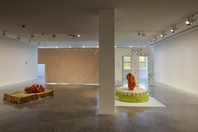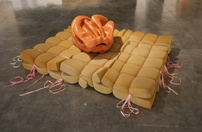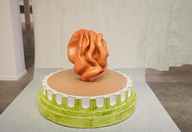Nicholas Smith
Naarm/Melbourne
2023
Displayed 2023 at Museum of Contemporary Art Australia

Nicholas Smith
Born 1990, Geelong, Victoria
Lives and works Naarm/Melbourne
Nicholas Smith investigates queerness, sexuality, identity and memory in his works, often employing diverse media including ceramics and found materials. In 2019, Smith was awarded the American Friends of the National Gallery of Australia AusArt Fellowship and in 2022, completed a Masters of Fine Art, Visual Art at ArtCenter College of Design, Los Angeles. Smith’s works have been featured in recent exhibitions including Queer: Stories from The NGV Collection, National Gallery of Victoria, Melbourne (2022); Future Inheritance, NGV Design Week, National Gallery of Victoria, Melbourne (2021); Cooled pride, roused ardour, Bus Projects, Melbourne (2018); Swaddle me, West Space, Melbourne (2017); and I am crying, Firstdraft, Sydney (2017). In 2019, Smith was a finalist in the Midsumma and Australia Post Prize, Melbourne, and in 2016, was a finalist in the Substation Contemporary Art Prize, Melbourne.
Photograph: Vivian Nilan
Image courtesy the artist
Artist text
by Jeremy Eaton
In a 2021 discussion, author Garth Greenwell expressed that queerness is a sensation that emerges from ‘affective allegiances and libidinal impulses,’ which constitute a ‘sufficient authority for the practice of art.’ (1) Greenwell’s embodied understanding of queerness and the guiding authority of affect resonates when considering Nicholas Smith’s work in The National 4. Smith’s work is not rooted in an argument about queerness or personhood. Instead, his work manifests through a series of affective identifications between his upbringing in regional Victoria, the oeuvre of Australian artist Adrian Feint (1894–1971), interior décor, and the pleasure Smith takes in his working materials.
Most prominent of these identifications are several black-and-white printouts of Feint’s flower paintings from the 1940s and 50s, which are referenced in Smith’s gridded palimpsest, decorator's touch (screen) (2023). Feint’s works superficially appear like the floral adornments of a polite, wallpapered interior. Yet the evocation of Feint runs deeper. Feint, like Smith, relished in interiors, aestheticism, and finery. Both artists play with the spatial experience between interior and exterior, blending and bleeding one state into the other, punctuating their compositions with moments of sensual release – be that the exuberant, extra-natural cornucopias in Feint’s work, or the sudden apparition of a nude body in Smith’s installation.
Feint often drew from views of Sydney, and painted flowers from the gardens of wealthy patrons or gathered from the vicinity of his home. Similarly, Smith draws from what is at hand, and selects materials, colours, and surfaces particular to regional Victoria or derived from relationships between friends and family. Smith subsequently composes these relations into spaces and objects that generate bodily resonances. As sculpturally dense terracotta vessels, decorator's touch (body 1) and decorator's touch (body 2) (2023) appear like garden statuary and writhe like Laocoön and His Sons, seemingly caught in states of ecstatic repose. This effect is further enhanced as the bodily vessels are set in a tableau replete with provisional cardboard columns and a vinyl backdrop, all of which are composed of traditionally ‘poor’ materials. It is like a handmade, suburban classicism framed by cool, green automotive vinyl once used to upholster the seats of 1980s Fords and Holdens – whose patchwork, in Smith’s hands, evokes the rolling hills and colours of country Australia.
These unorthodox yet specific material combinations (and their evocations) can be read as diaristic, but they also operate within broader communal experiences, specifically by overturning expectations of value and the masculinist underpinnings inherited from the traditions of architecture and sculptural practice. These inversions become more complex still when drawn, as they are, into the realm of the interior, where Smith challenges décor as a ‘mere’ arbiter of taste, status, and value. Smith has instead created a provisional setting of personal identifications, inflected by desire, teasing the libidinal, sexual, and pleasurable to the fore. Here, the body comes back in the form of idiomatic gestures drawn from an ostensibly queer art history, and as stains and references to piss. And as we trace the pleasurable and sensual surfaces and objects orchestrated by Smith as a series of slow reveals, we too are offered an opportunity to trace the affective and libidinal impulses that can be gleaned from beneath the surfaces that course through our homes, the landscape, and the past.
(1) The Centre for Fiction, ‘Queer Theory / Queer Fiction with Carolyn Dinshaw and Garth Greenwell’, YouTube, 18 November 2021, https://www.youtube.com/watch?v=QKvUsYDm2VY
Nicholas Smith
7min
Artist's acknowledgements
The artist thanks Vivian Nilan for their studio assistance, Pie Bolton for their firing expertise, Kris Filippi from KJF Custom Trim for the vinyl offcuts, and Jeremy Eaton for their catalogue essay.


